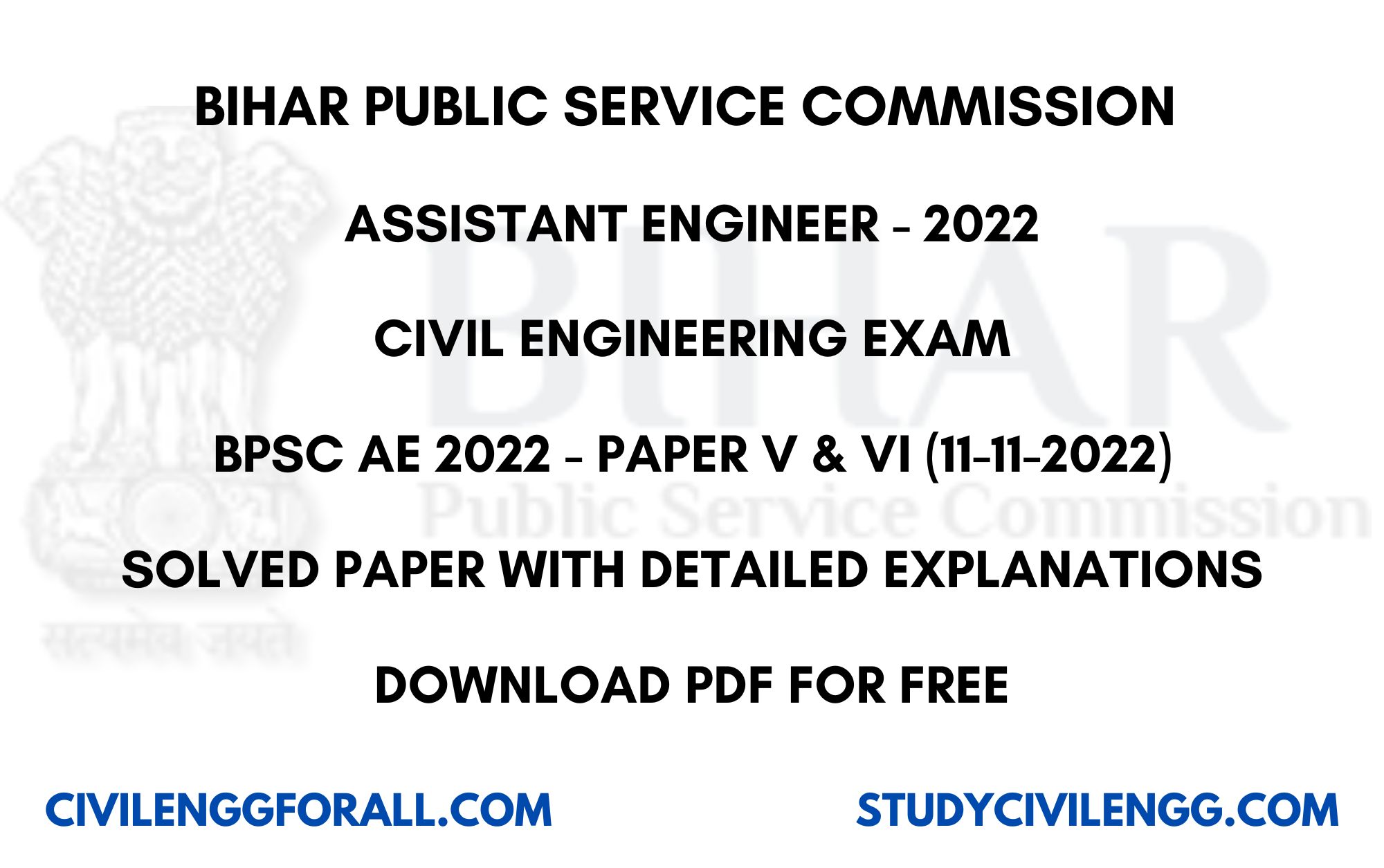BIHAR PUBLIC SERVICE COMMISSION ASSISTANT ENGINEER (BPSC AE) 2022 CIVIL ENGINEERING EXAM SOLVED PAPER WITH EXPLANATIONS PDF (StudyCivilEngg.com)
BIHAR PUBLIC SERVICE COMMISSION
ASSISTANT ENGINEER RECRUITMENT
CIVIL ENGINEERING EXAM - 2022
SOLVED PAPER WITH EXPLANATIONS
FREE DOWNLOAD PDF
- Understand the Bihar-specific Aspects: Since the BPSC exams are conducted by the Bihar Public Service Commission, it's important to have a good understanding of the state-specific aspects related to governance, history, geography, economy, and current affairs of Bihar.
- Refer to Bihar-specific Study Material: Look for study material that covers Bihar-specific topics. This could include books, online resources, and current affairs magazines focusing on Bihar.
- Current Affairs: Stay updated with current affairs, especially those related to Bihar. Focus on important events, government schemes, and initiatives taken by the Bihar government.
- Bihar GK: Brush up on your knowledge of Bihar's history, culture, politics, and geography. Questions related to Bihar's GK are often asked in BPSC exams.
- Practice Previous Year's Papers: Solve previous years' question papers specifically for BPSC exams. This will give you an idea of the type of questions asked and the exam pattern.
- Mock Tests and Practice Sets: Take BPSC-specific mock tests and practice sets to assess your preparation. This will help you get accustomed to the exam pattern and improve your speed and accuracy.
- Language Proficiency: Ensure proficiency in English and Hindi, as BPSC exams may include questions in both languages.
- Time Management: Practice time management during your preparation and while taking mock tests. BPSC exams often have a vast syllabus, so managing time effectively is crucial.
- Revision Strategy: Develop a revision strategy that allows you to revise both core concepts and Bihar-specific topics
Download our BPSC AE 2022 Civil Engineering exam solved paper with explanations PDF to make best use of it for your BPSC AE Exam preparation as one of the key steps of preparation is going through the previous years solved papers.
BIHAR PUBLIC SERVICE COMMISSION ASSISTANT ENGINEER (BPSC AE) 2022 CIVIL ENGINEERING EXAM SOLVED PAPER WITH EXPLANATIONS - SAMPLE QUESTIONS FROM THE PDF
EXAM DATE: 11/11/2022
PAPER - V & VI
(a) IS 2250: 1981
(b) IS 2116: 1980
(c) IS 456 : 2000
(d) IS 1332 : 1982
Ans. (a) : IS 2250: 1981 - Code of practice for preparation and use of masonry mortars.
IS 2116: 1980 - Sand for masonry mortars
IS 456 : 2000 - Plain and reinforced concrete
IS 1332 : 1986 - Precast reinforced concrete street lighting poles
QUESTION 3: Negative skin friction on piles is dominant in
(a) friction per bearing piles
(b) piles resting on hard sands
(c) friction piles in soft clays
(d) friction piles in sands
Ans. (c): Negative skin friction occurs when concrete piles are situated in soft soils, consolidating soil-mass, etc., resulting in a downward force that increase loading on shaft piles and reduces the bearing capacity of the piles.
(b) piles resting on hard sands
(c) friction piles in soft clays
(d) friction piles in sands
Ans. (c): Negative skin friction occurs when concrete piles are situated in soft soils, consolidating soil-mass, etc., resulting in a downward force that increase loading on shaft piles and reduces the bearing capacity of the piles.
QUESTION 4: Higher density and a lower optimum water content is easily achieved by
(a) saturated soil
(b) coarse grained soil
(c) fine grained soil
(d) cohesion-less soil
Ans. (b) : Well graded coarse-grain soil attains a much higher density and lower water optimum water content then fine grained soil which requiring more water
(b) coarse grained soil
(c) fine grained soil
(d) cohesion-less soil
Ans. (b) : Well graded coarse-grain soil attains a much higher density and lower water optimum water content then fine grained soil which requiring more water
QUESTION 5 : Ratio of bearing capacity double under reamed (UR) pile to that of single-reamed pile is nearly
(a) 1.7
(b) 2
(c) 1.5
(d) 1.2
Ans. (c) : According to IS 2911: part I 1973, the ratio of bearing resistance for double under-reamed pile is 1.5 for sandy and clayey soils including black cotton soils.
(b) 2
(c) 1.5
(d) 1.2
Ans. (c) : According to IS 2911: part I 1973, the ratio of bearing resistance for double under-reamed pile is 1.5 for sandy and clayey soils including black cotton soils.
QUESTION 6. Stokes' law is applicable to soil particles of size between
(a) 0.2 mm to 2 m
(b) 0.3 mm to 0.2 m
(c) 0.2 mm to 0.0002 mm
(a) 0.2 mm to 2 m
(b) 0.3 mm to 0.2 m
(c) 0.2 mm to 0.0002 mm
(d) 0.3 mm to 3 m
Ans. (c) : Stoke's law valid for range of diameter of particle - 0.2 mm to 0.0002 mm.
If particle size is greater than 0,2 mm, then turbulent motion will occur and if particle size is smaller than 0.0002 mm, then Brownian motion will occur.
Ans. (c) : Stoke's law valid for range of diameter of particle - 0.2 mm to 0.0002 mm.
If particle size is greater than 0,2 mm, then turbulent motion will occur and if particle size is smaller than 0.0002 mm, then Brownian motion will occur.
DOWNLOAD LINK : BIHAR PUBLIC SERVICE COMMISSION ASSISTANT ENGINEER (BPSC AE) 2022 CIVIL ENGINEERING EXAM SOLVED PAPER WITH EXPLANATIONS PDF
PASSWORD: StudyCivilEngg.com
RELATED LINKS
- SSC JE 2023 CIVIL ENGINEERING EXAM SOLVED PAPER PDF
- NHPC JE CIVIL ENGINEERING 2022 EXAM SOLVED PAPER PDF
- APPSC AEE CIVIL ENGINEERING 2022 EXAM SOLVED PAPER PDF
- MPSC ENGINEERING SERVICES 2011 CIVIL ENGINEERING EXAM SOLVED PAPER PDF
- RSSB JUNIOR ENGINEER DIPLOMA 2022 CIVIL ENGINEERING EXAM SOLVED PAPER PDF (HINDI & ENGLISH EDITIONS)
- ISRO TECHNICAL ASSISTANT 2022 CIVIL ENGINEERING EXAM SOLVED PAPER PDF (HINDI & ENGLISH)





Post a Comment